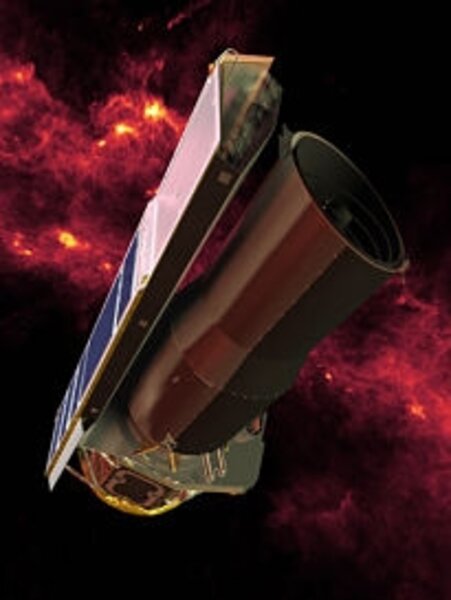Galaxies caught in cosmic taffy pull
Loading...
The universe is filled with some odd-ball galaxies. Take ARP 261, for instance.
It's very a rare breed of interacting galaxies -- a so-called "taffy" pair. Only three taffy pairs have been discovered so far.
These form as two spiral galaxies smash together face-on like colliding dinner plates -- but live to tell the tale (as colliding galaxies are wont to do if one doesn't capture the other). Each galaxy passes through the other. As they separate, they exert a gravitational tug on the gas and dust in the gap between them, a bit like folks working the candy at an old-fashioned taffy pull.
For astronomer Beverly Smith, ARP 261 and its ilk represent extreme labs for studying star formation rates in galaxies that interact with one another. This week, she and her colleagues are using the Spitzer Space Telescope to observe ARP 261 and another so-called "taffy" pair of galaxies, UGC813/816.
It's all in the name of understanding what happens to rates of star formation across a range of galaxy interactions -- from the head-on collision to the near-miss.
Why bother? Early on, the universe was much smaller, and galaxy collisions -- including these cosmic high fives -- are thought to have been common. So in a sense, interacting galaxies in our own neck of the cosmos are windows on an important trigger for star formation when the universe was young.
ARP 261 is some 70 million light years away in the constellation Libra. It appears in an atlas of bizarre galaxies compiled by astronomer Halton Arp, who spent 28 years at Mt. Wilson and Mt. Palomar observatories in southern California building the cosmic photo album. It was published in 1966.
Twenty-seven years later, radio astronomer Jim Condon and his colleagues coined the term "taffy galaxies" in a 1993 paper describing their observations of a galaxy pair with the ungainly label UGC 12914/5.
Fast forward to this week.
The objective is to observe what happens to the dust and gas between stars, the so-called interstellar medium, in the aftermath of a head-on collision, explains Dr. Smith, an associate professor at East Tennessee State University in Johnson City, Tenn.
Typically, this dust and gas represent the stuff from which new dense molecular clouds form. These clouds serve as breeding grounds for stars and planets.
Nature provides the experiment
"In most cases, galaxies just swing by each other" and they undergo bursts of star formation, she explained during a phone chat. "But what if we smash them right into each other?"
It's well known that the stars in each galaxy, as well as existing molecular clouds, are so far apart they they tend to miss each other as one galaxy moves through the other.
But the raw material for the clouds?
Typically, the gas in the interstellar medium, say hydrogen, is made up of hydrogen molecules. But models and observations suggest that the collision energy in a head-on smack-down is high enough to split the molecules into their individual atoms and strip the atoms of their electrons. The gas becomes ionized.
And what happens to the dust? That is less well-known. In principle, shock waves could roil the dust and even destroy it.
Both effects would slam the brakes on star formation. Over time, say a billion years or so, the ionized gas would cool and recombine into molecules, once again becoming more favorable for star and planet formation, Smith explains.
To check the effect of these head-on collisions on dust, Smith and her colleagues are using Spitzer -- which operates at infrared wavelengths.
Spitzer also will reveal what happens to compounds known as polycyclic aromatic hydrocarbons. These also appear in interstellar medium. Among their other traits, PAHs can be used to form primitive membranes. Some astrobiologists suggest such membranes could have played a key role in the chemistry necessary for the emergence of organic life on Earth.
A look at lots of wavelengths
Once Smith and her group have gathered the Spitzer data, they will combine it with data from the Hubble Space Telescope, which can pick out individual clusters of new stars in each galaxy, as well as data at other wavelengths. Then they can compare what they see at ARP 261 and at UGC 12914/5 to similar observations from other interacting galaxies.
Do the taffies really have fewer clusters of very young stars than other interacting galaxies? Do current ideas about the effect of these head-on collisions on the interstellar medium hold up?
Stay tuned ... but don't hold your breath. Smith estimates that it may take a year or so to subject the data to the kind of scrutiny needed to begin writing this chapter in the story of taffy galaxies.






